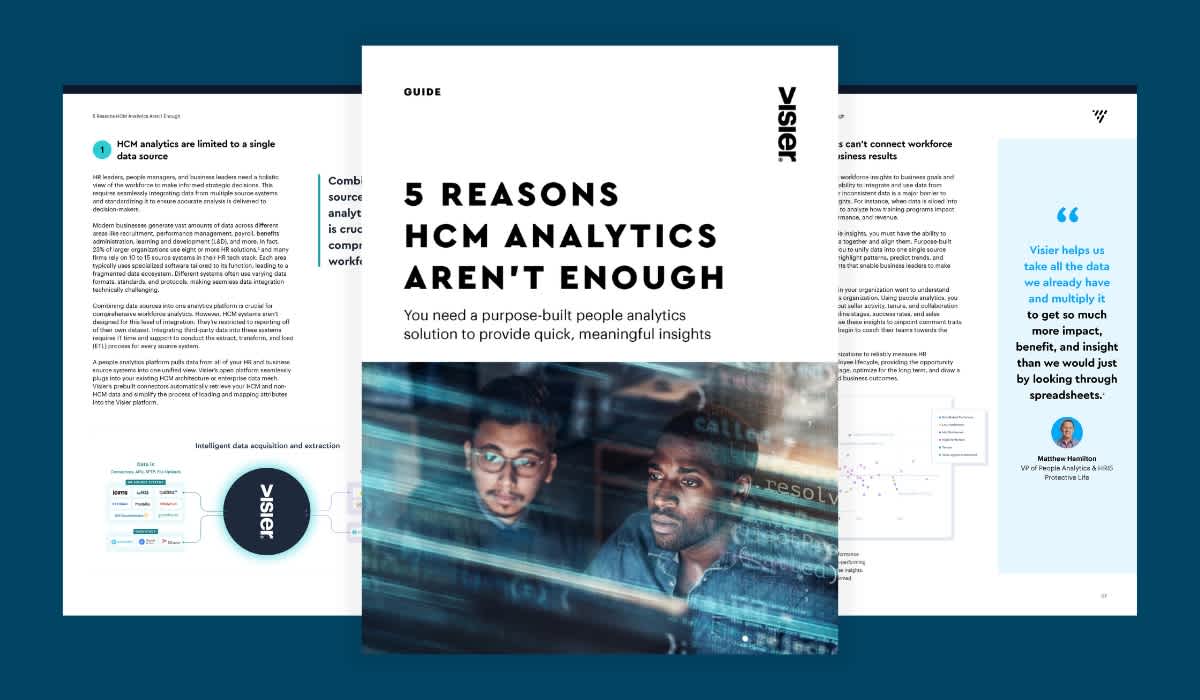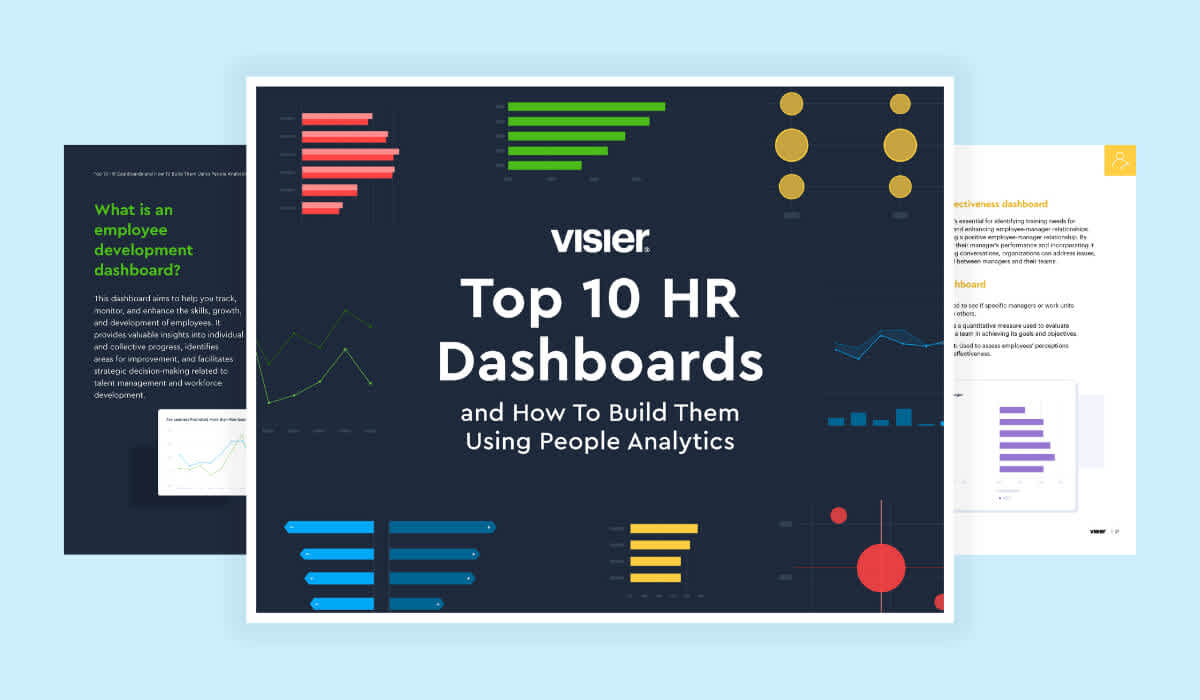HCM Analytics Can’t Answer Your Most Important HR Questions
Learn why HCM analytics and basic reports alone aren't enough and how you can use people analytics to deliver deeper HR insights.

While human capital management (HCM) systems are powerful tools for automating and managing HR data processes, they fall short in providing detailed analytics customized to specific business needs. People analytics can solve many of the limitations of HCM systems. The two need to be used together strategically.
HCM systems are transactional and focused on automating key HR processes. People analytics provide strategic workforce insights to help HR leaders make better decisions. People analytics can ensure that HCM systems are aligned with strategic business needs.
People analytics can provide a unified view for HR and C-suite leaders by combining data from multiple HR sources—something that 66% of organizations report is difficult to do.
What’s the difference between HCM analytics and people analytics?
HCM analytics provide basic reports pulled from data that is housed in HCM systems like Workday, Oracle Fusion, SAP SucessFactors, and others, which are designed to provide information on processes like recruiting, retention, diversity, compensation, and workforce planning. These basic reports are important and useful, but they don’t go far enough to yield truly meaningful strategic insights.
That’s where people analytics come into play. People analytics deliver actionable insights by ingesting data about employees and the organization and converting it into useful information to enhance critical talent and business outcomes.
People analytics simply offers more.

There are three critical limitations to HCM analytics that can threaten HR leaders’ ability to make well-informed and strategic people decisions: data source limitations, lack of analytical depth, and a lack of self-serve capabilities. We’ll break down each of these in more detail here.
1. HCM systems are limited to a single data source
Combining data sources into one analytics platform is crucial for comprehensive workforce analytics. But, HCM systems aren’t designed for this type of integration. HCM systems are restricted to reporting only on the data within their own dataset. Integrating third-party data into these systems requires IT time and support to conduct the extract, transform, and load (ETL) process for every source system.
To deliver people insights that inform critical business needs, organizations need multi-source people analytics that combine people data with business data from disparate systems so that data can be linked to insights that can drive action.
Relying on the single source of data that HCM systems provide limits strategic workforce insights, data integration capabilities, and the ability to model scenarios and forecast future needs. Analysis is restricted to HR processes and metrics like retention or training outcomes, without the ability to tie them to broader business outcomes like revenue, productivity, and customer service quality.
Additionally, most HCM solutions lack predictive analytics and machine learning capabilities critical for identifying risks, optimizing processes, and driving meaningful and measurable impact.
2. HCM analytics aren’t built to provide in-depth analytics
HCM analytics serve their purpose, which is to provide answers to basic workforce questions. However, reporting capabilities are limited to static reports and charts that provide a snapshot of a single point in time—the time when the report is pulled. This can lead to reliance on outdated information. Exploring data in more depth requires stakeholders to request follow-up reports. That can be time-consuming and delay critical decisions.
The ability to tie workforce insights to business goals and outcomes simply isn’t possible with HCM analytics because they can’t integrate and use data from multiple sources. HCM outputs are drawn only from the HCM system itself which provides a narrow view of workforce data. This limited scope restricts the depth of insights to make informed decisions.
In addition, HCM analytics are built on rigid data models that can’t easily adapt to changing business needs or incorporate unstructured data sources like text, images, and video.
3. HCM analytics don’t allow for self-serve data exploration
There is a steep learning curve with HCM analytics that requires specialized engineering resources to maintain. The time and resources required to keep users trained on these systems can represent a significant barrier, limiting the effectiveness of HCMs in delivering comprehensive workforce analytics.
Visier research reveals that providing managers with people data and insights directly can lead to significant productivity and profitability gains. In fact, an organization with 10,000 employees could see nearly $400 million in productivity and profitability value simply by providing managers with seamless, self-serve options to access the data they need when they need it. When managers can make better-informed decisions about their teams, efficiencies are gained and bottom line results improve.
HCM systems and people analytics work best together
There is a place for HCM analytics—alone, and in combination with people analytics. Savvy, people-focused organizations use HCM solutions like Workday, SAP SuccessFactors, and Oracle Cloud HCM to manage HR transactions and leverage people analytics to answer more complex, strategic questions.
HCM analytics can provide basic workforce insights and metrics related to headcount, compensation, recruiting, and compliance. This data can be useful for operational reporting and monitoring core HR processes. However, this type of reporting lacks flexibility, offers no predictive capabilities, and can carry hefty costs for add-on analytics modules from HCM vendors.
People analytics platforms are designed to provide deeper, more strategic workforce insights by integrating data from a wide range of sources—both HR and business metrics. People analytics also provide predictive analytics options and leverage AI and machine learning for prescriptive recommendations. Workforce metrics can also be benchmarked against industry peers for comparative purposes.
Combining the best of both HCM and people analytics allows HR organizations to use both tools in a complementary manner—HCM to record core HR processes and transactions, and people analytics to combine HCM data with other data sources for a complete view of the employee lifecycle and business impacts.
Move from basic reporting to outcome-focused analytics
HCM systems can provide valuable capabilities for managing core HR processes, but their analytics often fall short when it comes to more strategic workforce planning and forward-looking decisions.
Combining the power of HCM systems and people analytics platforms like Visier allows HR leaders to unlock deeper insights from their people data—especially when that data is tied to other key business performance metrics.
Visier's purpose-built people analytics capabilities and robust data validation and estimation rules enable organizations to drive better business outcomes and make more informed talent decisions.
Visier can complement your HCM by:
Improving data integrity in source systems
Securely delivering insights at scale
Making predictions with accuracy
Saving time, money, and resources
Keeping up with people analytics innovations
By using HCM systems for operational HR processes and people analytics for strategic decision support, organizations can truly unlock the full potential of their workforce data.

More about reports vs. analytics
Businesses rely on analytics to make sound decisions, but the difference between reports and analytics can be confusing. Learn the differentiators between reports and analytics.
Discover how analytics are produced and why transactional solutions can only support reports. This is an introduction to people analytics technology.
Predictive HR analytics let you make predictions and forecasts about future performance based on historical HR data. Learn more here.


